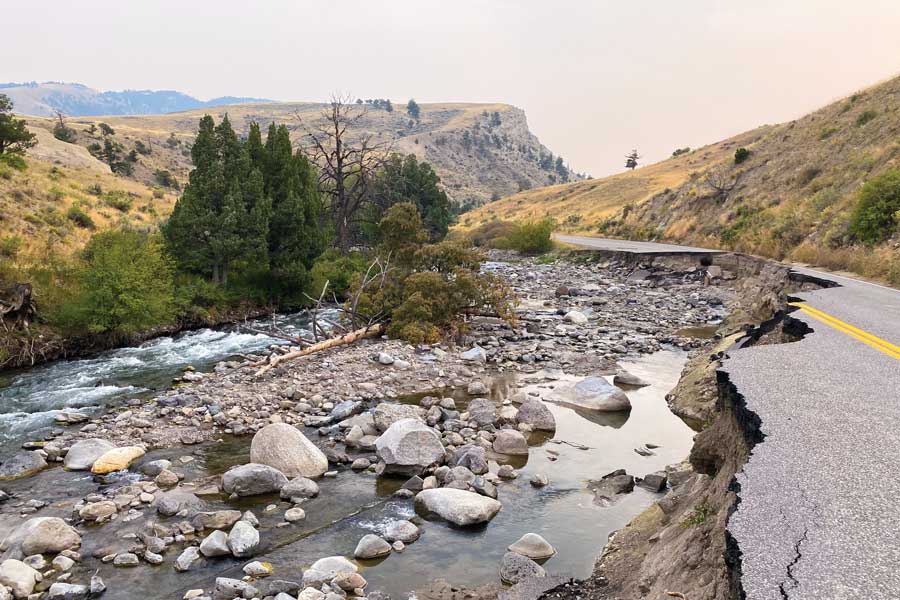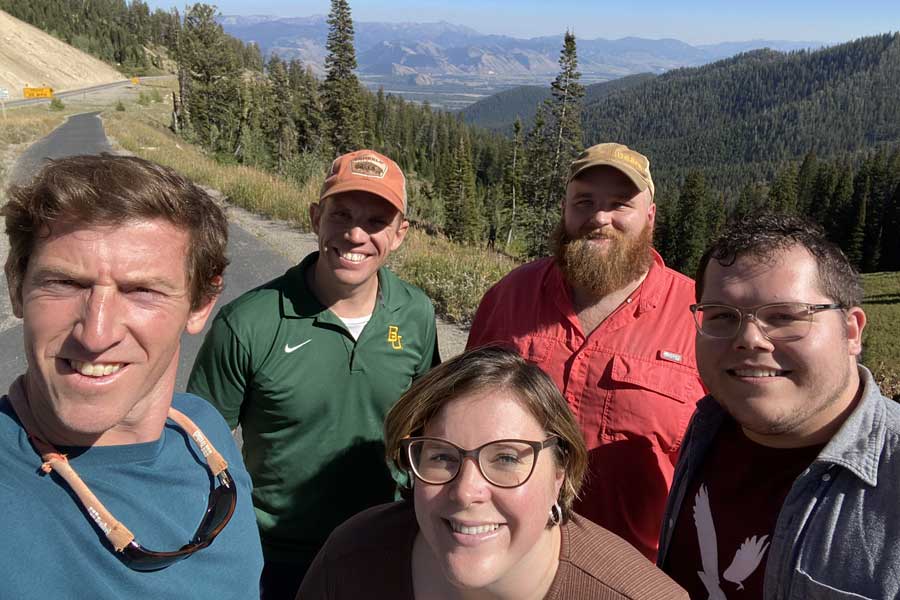Yellowstone
For one Baylor researcher, a family vacation becomes a launching pad to use research to serve communities in need.
When the rain began to fall on the morning of June 13, 2022, no one in or around Yellowstone National Park knew that a once in 500-year event was underway. Record rainfall and snowmelt would soon pound away at the roads that served as the main arteries through the park, shutting out visitors to one of the nation’s iconic natural landmarks — and cutting off the communities that serve them from the supplies they need and the visitors who sustain them.
A Rapid Response
Just outside the park, Ryan McManamay, Ph.D., and his family had convened to celebrate his parents’ 50th wedding anniversary. McManamay, assistant professor of environmental science at Baylor, is a spatial ecologist whose research focuses on the relationship between humans and environmental systems, with a particular interest in infrastructure. As they neared the park they had visited many times together, road signs heralded the news: “All gates closed to Yellowstone.”
Soon discovering the cause, McManamay and his family were cut off from Gardiner, Montana, a town of 900 at the park’s north entrance, where they had planned to stay. But rather than focusing on a trip spoiled, he turned to his discipline — from vacation to vocation in short order.
With the support of a rapid grant from the National Science Foundation (NSF), McManamay and a team of Baylor students and colleagues returned weeks later to visit with owners of nearly 250 businesses in Gardiner and surrounding communities impacted by the flooding within the park. While the flooding approached $1 billion in damages, most infrastructure loss occurred in Yellowstone National Park. However, much of the economic toll was felt by the business owners and families reliant on tourism for their livelihood. Deeply moved by the resilience and grit of people, McManamay has focused in the months since on understanding the relationship between community dependence on natural systems, with a focus on seeing those systems as critical infrastructure.
“We prize national parks like Yellowstone and hold them dear to us. Beyond mere aesthetics, they’re shown to be critical to human health and economic vitality,” McManamay said. “When something happens like a 500-year flood, the park service isn’t equipped like U.S. DOT programs to rapidly mobilize. I think in terms of how our society responds to losses in critical infrastructure. Natural disasters in natural settings are handled very differently and on different time scales. When we think of America’s national treasures, such as national parks, we don’t think of natural disasters or how they could pose risk to human livelihoods. Yet they have a really important purpose, including supporting the economic vitality of surrounding communities.”
The Impact On Gateway Communities
Most anyone who has visited a national park has either stayed in, or passed through, the gateway communities that facilitate millions of visitors nationwide. Gardiner, Montana, is one such town. With a population approaching just 900 people, the community still served approximately 1 million visitors in 2021.
“I don’t know that people realize how much gateway communities support the parks. It’s not that the National Park Service couldn’t function without us, but I don’t think it would be easy,” Terese Petcoff, executive director of the Gardiner Chamber of Commerce said. Petcoff worked closely with McManamay and his team on the ground in Gardiner and has since stayed connected.
“There’s no way that all visitors to our national parks could stay within park boundaries. They have to stay in gateway communities. And when you’re in a place like Gardiner, we don’t have box stores or corporations. It’s all family businesses.”
After McManamay received the NSF Rapid Grant — emergency grants specifically given to enable the collection of time-sensitive data — Petcoff helped connect him with many local business owners, and McManamay has in turn helped Petcoff and colleagues stay connected to grant opportunities as they rebuild financially.
Ryan McManamay, Ben Ryan, Jillian Sturtevant, Jordan Jatko and Josh Beard standing at overlook at Teton Pass between Victor, ID, and Jackson Hole, WY.
“In a lot of ways, the flood was the equivalent of COVID to Gardiner,” Petcoff said. “We’ve continued to deal with impacts — it’s a ripple effect. Once they shut down the north entrance and started rebuilding the road, we were wiped out economically. In town, we didn’t have physical damage — everything looked normal. Economically, it was a different story. Our season was really done at that point, a time when our business owners typically make the bulk of the profits that sustain them.”
Joining McManamay in investigating those impacts was Ben Ryan, Ph.D., clinical associate professor of environmental science, and colleagues from Montana State University and Northern Arizona University along with Baylor Ph.D. students, Jillian Sturtevant and Jordan Jatko, from McManamay’s lab, and Joshua Beard, a film and digital media student videographer. Over a week in September, they surveyed business owners, held a community resilience workshop and built a collection of data that will be used to help Gardiner and communities like it.
“There’s a grit and backbone behind the people there,” McManamay said. “They’ve been shaken and faced losing everything, but the vast majority of them remain optimistic. They have every reason not to be when you hear their stories of how much the flooding has impacted their business and their income. You can’t help but feel compassion and want to say, ‘thank you for not giving up.’”
National Parks As Critical Infrastructure
Even before his vacation, McManamay had been pondering infrastructure negotiations that would eventually become the $65 billion Bipartisan Infrastructure Deal. Last fall, a memorandum from The White House — “A New National Strategy to Reflect Natural Assets on America’s Balance Sheet” — called for an increased understanding of the valuation of natural assets. McManamay sees a tie between these efforts and his research. While roads through a park are not currently considered critical infrastructure, the data collected through the project in Gardiner and other gateway communities could help others view natural parks and resources through a new lens.
“When we think of America’s national treasures, such as national parks, we don’t think of natural disasters or how they could pose risk to human livelihoods. Yet they have a really important purpose, including supporting the economic vitality of surrounding communities.”
“We depend on natural assets in so many important ways, and Yellowstone is just one example of how these areas provide for our society,” McManamay said. “We need to be ready to fix these issues quickly because so many people depend on them.”
The data and efforts of McManamay and his team are already being put to multi-faceted use. The Economic Development Agency is using the survey to determine the level of federal support needed for the region. A second use involves quantifying the extent of infrastructure damage after the winter. McManamay plans to return in the summer to further measure the extent of damages both in the park and the cascading effects outside the park and examine the resilience of their infrastructure. Tying into the White House memorandum, information gleaned can expand understanding of the long-term impact of a resilient infrastructure within and around national parks, with hopes for future projects with the NSF. Natural outgrowths of this work include papers, grants and, McManamay someday hopes, a renewed national look at the role of natural assets.
While those goals remain meaningful, simply serving the people of Gardiner has touched the hearts of McManamay and his students.
“Sometimes we can get buffered from the realities faced by others, drawing conclusions about the way the world works. Then, you see a sobering experience like this, and it’s very meaningful to be able to help, at least in a small way. That’s a reason why I’m glad to be at Baylor. There are so many examples of faculty motivated by an opportunity to serve. It’s an outpouring of our Christian faith and the mission of this University, to help people — it’s a drive here to share the love of Christ.”

